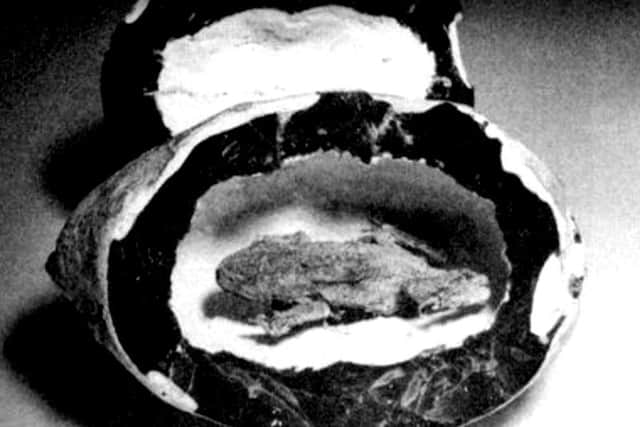The story of the 6,000-year-old entombed Hartlepool toad which was still alive - or was it?
and live on Freeview channel 276
It made the pages of the national press when the amphibian was still breathing after it was cut out of solid rock.
But there was a twist and historian Graeme Harper is the man to tell us more.
Advertisement
Hide AdAdvertisement
Hide AdThe idea that animals - exclusively frogs or toads - can be entombed inside solid rock and survive for thousands, if not millions, of years had long been a scientific puzzle.


In 1955, even Merrie Melodies was getting in on the act when it introduced a new character to cinema audiences: a spectacularly talented
creature called Michigan J Frog, in an animated short entitled’ One Froggy Evening ‘.
The amphibious hero emerged from inside a solid brick which had broken open during a building demolition. Wearing a top hat and twirling a cane, Michigan quickly revealed a long dormant ability as a song and dance performer.
Advertisement
Hide AdAdvertisement
Hide AdIt may sound like a bizarre premise for a cartoon, but it was based on an existing mystery that had long caught the public imagination.


The best known example in Britain happened in Hartlepool on April 7, 1865.
During excavations for a new waterworks, workmen unearthed a block of magnesium limestone which was twenty-five feet under the surface. When this was broken up, they were astonished to see a live toad encased in the freshly broken rock. The cavity it had been freed from was no larger than its body and appeared to have been formed around the creature.
Its mouth was said to be sealed shut, and the creature made a ‘barking sound ‘through its nostrils when touched. It was reported that the
Advertisement
Hide AdAdvertisement
Hide Adtoad’s feet were turned inwards, and its hind legs were longer than that of a normal specimen. Its eyes were unusually bright.
One newspaper claimed that the toad was of a pale colour similar to that of the stone in which it had been embedded.
It soon turned an olive brown, the paper added.
The creature was placed in the possession of Mr Horner, the president of the Natural History Society before being examined by Rev Robert Taylor, Rector of St Hilda’s Church - a well-known amateur geologist and author.
Rev Taylor claimed that the toad must be at least six thousand years old. The ancient amphibian, and the rock from whence it came, were then put on display in the Hartlepool Museum where it quickly became a popular attraction.
Advertisement
Hide AdAdvertisement
Hide AdA retrospective article published in the Northern Daily Mail in December 1930 stated that ‘his toadship was visited during its exhibition by people from all parts and, like the professional- beauties, was frequently photographed.’
The toad it seems could withstand thousands of years in an enclosed chamber without food or air but could not cope with the outside world. Another newspaper broke the news in 1865 that the toad had died after it was injured by people from Newcastle on a visit to Hartlepool.
But many people were extremely sceptical about the issue. How could an air-breathing creature remain alive in such conditions and how did it get into a solid rock in the first place?
An organisation called the Manchester Geological Society turned their attentions to the Hartlepool case and immediately suspected foul play. They had been investigating a similar case in St Helens which they had found to be a hoax.
Advertisement
Hide AdAdvertisement
Hide AdWhat happened next is not clear. Subsequent reports suggest that the Manchester geologists visited Hartlepool to examine the toad and its rock, and that it appeared to them that the crevice in the rock hollow had been deliberately carved out with a chisel.
After initially denying any wrongdoing one of the workers allegedly confessed. The rock had been tampered with and an unfortunate passing toad had been placed into it.
However, in the Manchester Geological Society meeting of July 1865 there is no mention of anyone setting foot in the town at all. During the meeting, photographs of the Hartlepool toad were passed around to the highly sceptical members.
The toad was identified by an expert as a common toad and that the notion that it had no mouth was ‘a remark resulting from ignorance. Toads often breathed with their mouths closed, the air escaping through the pores in the skin.
Advertisement
Hide AdAdvertisement
Hide Ad‘The idea that these creatures could survive for thousands of years embedded in rock was received with ‘amused incredibility ‘. Furthermore, it was reported that the reverend ‘had denied uttering any such nonsense such as the toad was 6000 years old.’
Despite the derision of the Manchester Geological Society further local reports of toads found encased in rocks continued. One was found down a pit in Sherburn in 1865, another in a churchyard in Carlisle in 1866, and one at Low Fell, Gateshead in 1895.
The Hartlepool toad’s life as a national celebrity proved short-lived – as did the aforementioned Michigan J Frog - but it proved the inspiration for a poem entitled ‘The Epitaph on the Toad,’ which appeared anonymously in 1867.
‘But when his night gave place to light
He for his hot old quarters got
At briny Hartlepool
Farewell poor toad thy weary load
Of sun and moon shine o’er
Naught harms thee now, the hammer’s blow
Shall break thy sleep no more.’
Our thanks go yet again to Graeme for another great article and we will have more from him in the weeks to come.